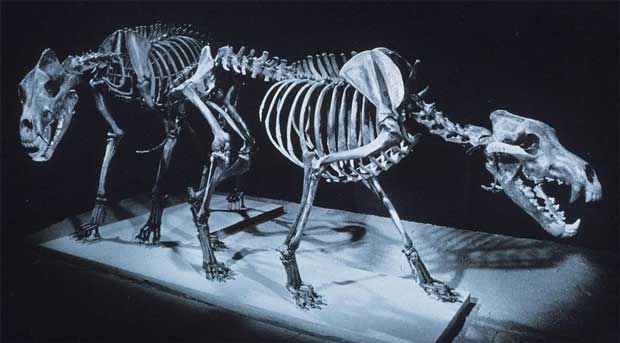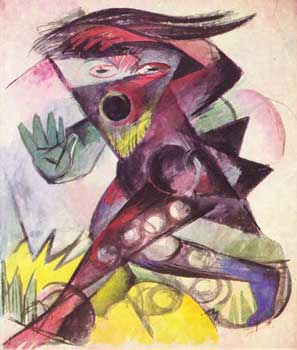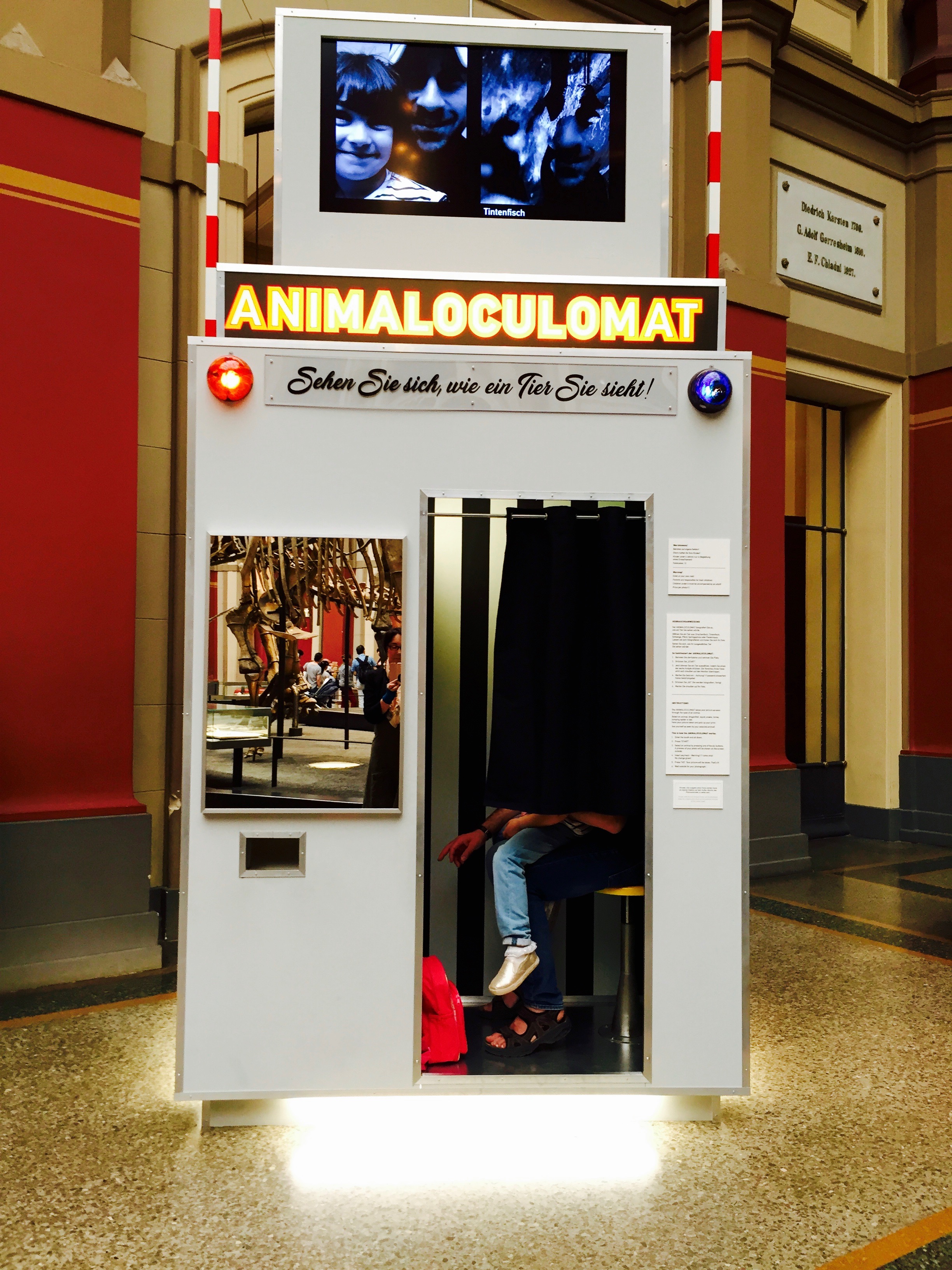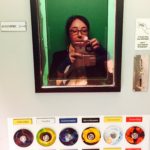
by Jean Marie Carey | 27 Mar 2018 | Animals, Art History, Franz Marc, German Expressionism / Modernism, Re-Enactments© and MashUps

Skeletons of dire wolves at the La Brea Tar Pits Museum, Los Angeles
One of the first animals I became fascinated with when I was very little was the dire wolf (canis dirus). This was not for the “dinosaur” reason (although I was also very interested in Sauropterygia), a sense of what-if nostalgia for an unknowable past, but for the opposite, that being just a bit bigger than wolves of today, and relatively recently extinct (in the late Pleistocene, about 10,000 years ago) surely there could be a few hanging out still in the Fagne.
Around the same time I was also horrified to learn of the existence of the La Brea Tar Pits, despite its amazing contents of millions of prehistoric animal remains. I couldn’t stop thinking about all the animals slowly suffocating in the tar. I guess I must have pushed this memory aside somehow because despite knowing that the tar pits were right in the middle of Los Angeles (also from the famous sequence in Bad Influence (1990)), I was astonished to see that the LBTP are immediately adjacent to the Los Angeles County Museum of Art.
Staying just down the street, I can walk through the excavation sites on my way to the museum. As many other people have commented the sunniness and wide-boulevardisation of Los Angeles compared to its low pedestrian density is uncanny already. Most of the time the paths around the tar pits are also eerily quiet. There have been a few days of heavy rain, and during those times of precipitation accumulation, water collects on top of the gravel, the grass, and the tar beneath. It’s a strange thing to witness.
Anyway the La Brea Tar Pits Museum has collected the skulls of more than 400 dire wolves, which yielding lots of information about the sizes and shapes of the animals and even allowed them to be divided into two subspecies, Canis dirus guildayi and Canis dirus dirus.

Bruce Nauman, “La Brea/Art Tips/Rat Spit/Tar Pits,” 1972

by Jean Marie Carey | 12 Jan 2018 | Art History, August Macke, Franz Marc, Re-Enactments© and MashUps
My research about the 1914 Franz Marc essay »Das abstrakte Theater« and Marc’s collaboration with Hugo Ball on an intended production of The Tempest has been published in a special arts issue of Empty Mirror. The fun long title of the article is “The Tempest and the Savages: Franz Marc, Hugo Ball, and a Decisive Moment in Dada-Expressionist Theater With a Special Appearance by August Macke,” and this piece contains important breaking historical avant-garde news.

Fig.01: Franz Marc, Fragmentary First Page of „Das abstrakte Theater,“ 1914. Das Archiv für Bildende Kunst im Germanischen Nationalmuseum, Nürnberg, Germany.
Here is the abstract: This article discusses the 1914 Franz Marc essay “Das abstrakte Theater” and the events surrounding an “Expressionist” production of Shakespeare’s Der Sturm planned by Marc and Hugo Ball the same year. Marc’s position in this detour from painting and writing can be understood in terms of his embrace of “die ‘Wilden’” – “the ‘Savages’” – an idea Marc introduces in 1912’s Blaue Reiter Almanac – as a metaphorical aspiration and as a state of being for both artists and the public as patrons of the arts and citizens of modernity. I also bring recognition to August Macke’s background in theatrical theory and design in terms of how this influenced Marc, particularly in analysis of the artists’ collaboration on Macke’s contribution to the Blaue Reiter Almanac, the essay “Die Masken,” and how this relates to the Der Sturm project. I propose a way of understanding how Marc’s beliefs in the paradoxically beneficial power of destruction dovetailed with Ball’s theology. In the context of this background information I give close reading of paintings Marc made of the Caliban and Miranda characters from Der Sturm. I also correct inaccuracies in the record regarding the chronologies of this encounter between these protagonists of Dada and Expressionism, and in our understanding of Marc’s text itself. Viewing this data in a holistic manner allows new interpretations of influences and collaborations amid the historical avant-garde.
It is great working with Denise Enck at Empty Mirror so it would be nice to look at the article on the Empty Mirror website, but if you would like a PDF of the article there is one here and also at Humanities Commons.

Fig.04: Franz Marc, Miranda, 1914. ( Tempera, 46 x 39.5 cm.) Kunstmuseum Basel, Kupferstichkabinett der öffentlichen Kunstsammlung, Switzerland.

Fig.03: Franz Marc, Caliban, 1914. (Figure for Shakespeare’s „Der Sturm“. Tempera, 46 x 39.5 cm.) Kunstmuseum Basel, Kupferstichkabinett der öffentlichen Kunstsammlung, Switzerland.

by Jean Marie Carey | 22 Sep 2017 | Animals, Animals in Art, Art History, Dogs!, Franz Marc, German Expressionism / Modernism
My article related to Franz Marc and his dog, “To Never Know You: Archival Photos of Russi and Franz Marc” has been published in the Fall 2017 issue of Antennae: The Journal of Nature in Visual Culture.
Here is the abstract for the story about Franz Marc and his dog, which also contains some valuable personal insights on vernacular photography from other scholars and benefited from the questions and comments from my Doktormutter Cecilia Novero:
-
This essay examines photographs of the German Expressionist artist, writer, and Tierliebhaber Franz Marc and his dog, Russi, taking the position that one of the most obvious characteristics of Marc’s life his – affectionate and respectful relationship with Russi – has been largely overlooked, though its documentation is clear. I extol the value of what are normally categorised as snapshots in reconstructing animal and human biographies. This raises questions about what photographs are valuable to such research, and why some are used repeatedly and others ignored. Significantly, a previously unknown photograph of Marc taken by his brother Paul in is published for the first time.
Mainly I had wanted to write about discovering this photo of Franz Marc in the DKM/GNM, so here it is again:

Franz Marc, 1914, in Munich. Photo by Paul Marc. Germanisches Nationalmuseum | Des Deutschen Kunstarchivs | Nürnberg

by Jean Marie Carey | 21 Jul 2017 | Art History, Franz Marc, German Expressionism / Modernism, LÖL, Re-Enactments© and MashUps
Much as I enjoy burying the lede, the headline on this story is that I found a heretofore unpublished photo, and this is the Franz Marc photo, taken in the spring of 1914 by the artist’s brother, Paul Marc, in Munich:

Franz Marc, 1914, in Munich. Photo by Paul Marc. Germanisches Nationalmuseum | Des Deutschen Kunstarchivs | Nürnberg
The whole story of finding the Franz Marc photo and a thorough analysis of why it might be that significant images of people and animals are overlooked is forthcoming in the second part of the “Exposing Animals” sequence of Antennae: The Journal of Nature in Visual Culture in September, and this photograph and some others will be reproduced there, but it is also appearing in a different kind of work I did for Empty Mirror Books that comes out this week, so I decided to post it, finally (I first found it in 2015!), here today.
Beyond standing as a strong reminder that there is so much we have not yet learned about the historical avant-garde, this is just a wonderful photograph, “eerie and magnificent,” as Marc would say, so I will just leave it at that for now.

by Jean Marie Carey | 7 Jun 2017 | Animals, Animals in Art, Art History, Dogs!, Franz Marc, German Expressionism / Modernism, LÖL, Re-Enactments© and MashUps

Klara Hobza, Animaloculomat, 2017
Already by 1909 Jakob Johann von Uexküll had, in Umwelt und Innenwelt der Tiere, given a great deal of consideration to the „Innenleben“ of animals. For Franz Marc this led to the question of how a horse, an eagle, a deer, or a dog saw and experienced the world, prompting the reflection „die Tiere in eine Landschaft zu setzen, die unsren Augen zugehört, statt uns in die Seele des Tieres zu versenken, um dessen Bildkreis zu erraten“.[1]
A painting like Liegender Hund im Schnee, a depiction of Marc’s dog Russi, radiates the oneness between the surrounding nature and the resting dog – „eine gemeinsame Stille von belebter und unbelebter Natur.“[2] .“ But Marc was interested in the actual physical reality of the dog’s vision as well.

Inside Klara Hobza’s Animaloculomat

by Jean Marie Carey | 3 Jun 2017 | Animals, Animals in Art, Art History, Franz Marc, German Expressionism / Modernism, Re-Enactments© and MashUps
“Vermisst: Der Turm der blauen Pferde von Franz Marc” at Haus am Waldsee, Berlin

Marcel van Eeden, High Mountains, a Rainbow, the Moon and Stars, 2017
I really wanted to like Haus am Waldsee’s thematic “Vermisst: Der Turm der blauen Pferde von Franz Marc,” but was also nervous about all the expectations of the referenced Franz Marc painting that I would bring to the exhibition. To (un)prepare, I imposed a media blackout upon myself, not reading up on who the artists were or any other reviews,[1] avoiding a seminar and joint show co-sponsored by the Pinakothek der Moderne in München. Vermisst’s concept was to pair some scholarly discussions of Marc’s missing 1913 masterwork with the expansions of contemporary artists upon its theme.
Franz Marc Painting Still Missing
Beyond mild speculation, a purpose of Vermisst did not seem to be to offer any type of meaningful investigation into where the painting might actually be. It is not incumbent upon Haus am Waldsee, where the Franz Marc painting was last seen in 1949, to conduct such an inquiry…and yet the stubborn refusal, still, of German museums and art historians to grapple with the issue of Raubkunst, particularly in a case as famous as that of Turm der blauen Pferde, where someone knows something, is a real problem. (I have an article coming out on this very subject, so I’ll just leave this here for now.)
Of contributions by a dozen artists, one seemed to address both the absent presence of TdbP and also the circumstances of its disappearance. In fact if Marcel van Eeden’s High Mountains, a Rainbow, the Moon and Stars (2017), a series of 26 prints including the text of a short story revealing some fantastical open-ended conclusions about what happened to the painting, had been the only component of the exhibition, that would have been fine. Only two of Eeden’s panels are in color, both reproductions of aspects of TdbP, which makes a nice allusion to the Wizard of Oz (1939), both in temporality and in the vibrancy of the world of dreams, and of lost alternative futures. (more…)
















 RSS - Posts
RSS - Posts